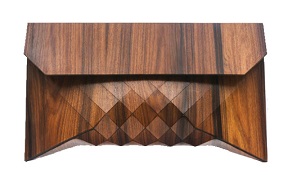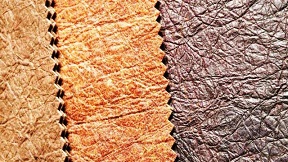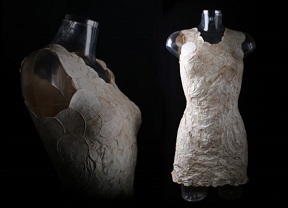Textiles made from pineapple leaves, self-massaging clothes, dresses made from fungi… During Material Xperience 2018 (13-15 March, Ahoy Rotterdam), fashion professionals can enjoy the marvel and the opportunities of many new materials.

Trends in new materials for fashion
According to the organizers of Material Xperience, there are some important trends in the fashion industry. The clothing industry is the most polluting industry globally – after the energy sector – and responsible for 10% of global CO2 emissions. And the industry’s water consumption is high: producing the outfit of one household will require some 1,000 bath tubs of water. Working conditions in low-wage countries are pathetic. As a result of all this, the fashions industry’s trends are towards sustainability, better working conditions, recycling, re-use and upcycling. In addition to that, new materials come to the market for working clothes and sportswear by application of smart materials and the addition of more functionalities like anti-transpiration or anti-radiation. New materials can also designed to be odourless, self-cleaning, fire resistant or with a shape memory. In the sector these are called e-textiles. These become smarter all the time, as the additional functions do not have to be added to the garment any more, but have become a function of the garment itself. 3D printing takes off as well: in the production of accessories, shoes and even entire outfits. Coatings and prints are no longer just aesthetic but functional as well, like water repellent, fire resistant and even for producing energy or changing form, e.g. colour or texture, as a communication device or for flexible insulation.

New materials
The most recent materials scouted will be shown in the independent Materia collection during the three-day event. Just a few examples.
Piñatex is a natural textile made of pineapple leaves fibre. These leaves are a side product of the pineapple harvest. Fibres are processed to produce a non-woven fabric that is an alternative to leather.
Recurf, a project of Amsterdam University of Applied Sciences, looks at reuse of textiles waste. A city like Amsterdam produces some 17 kg of textile waste per capita annually. A mere 16% is collected separately. The remainder will end up in municipal waste and be incinerated. The Recurf project intends to reuse the waste for production of new materials, among others by mixing it with a biobased plastic. And the project participants also try to develop a market for these materials, for instance for furniture produced from them.
Wood textile consists of a combination of wood veneer and textiles. The material is more or less flexible, due to the geometric wood finishing, a source of inspiration for many forms, ranging from handbags to small tables.

Major exhibition objects
Material Xperience not just shows the exhibition participants’ materials, it will also show major exhibition objects, often not on display before, that will lend a view on the future to the visitors.
Print in Motion: these prints, developed by Anouk van de Sande, represent an extra dimension. Although they look digital and futuristic, they are analogue in nature; they consist of several layers on stretching and transparent fabrics. The prints create an optical illusion by following the body’s movements. The effects are almost theatrical and make you dizzy when you watch them.
Smart textiles: designer and researcher Kristi Kuusk designs ‘smart textiles’. These textiles have integrated functions that react for instance when touched. By embedding sensors, the garments may be able to massage the wearer, or emit light.
MycoTEX is a textile made of mycelium, i.e. fungal spores. This material is very versatile, although used for solid objects only until quite recently. Textile designer Aniela Hoitink created a flexible version of this material that does away with the need to spin threads, and with weaving and sewing.
Fashion lectures program
During the Material Xperience event, there will be talked-about lectures. Lectures on ‘The Future of Fashion’ will be held on Wednesday afternoon 14 March. Material Xperience will be held 13-15 March in Ahoy, Rotterdam. For more information and a free ticket please visit the site of Material Xperience.
Interesting? Then also read:
Myco Design Lab: art meets industry in mycelium
Towards circular fashion
Design promotes the biobased economy

Recurf is a great initiative, combining textile wastes with biobased plastic to make furniture and other materials. It would be good to know the durability of products made from such combination.